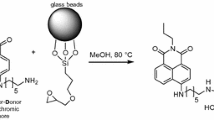Abstract
Purpose. 5-Bromomethyl fluorescein (5-BMF) was evaluated in this work as a pre-column, off-line derivatizing reagent for analytes containing a free carboxyl group. The reagent possessed high molar absorptivity and quantum yield and it's excitation maximum matched the intense 488.0 nm emission line of an argon ion laser. The thermal and photo-stability of the reagent were also suitable for our work.
Methods. A mixture of 5-BMF,. palmitic acid, 18-crown-6 and potassium carbonate was reacted at 76°C for one hour. The reaction yield was maximized by a sequential single-factor optimization of the reaction variables. Spectral characterizations were accomplished using conventional instrumentation and detection limits were evaluated using a laboratory constructed laser-induced fluorescence (LIF) detector which was optimized for concentration detection.
Results. Two apparent conjugates of palmitic acid were formed under the reaction conditions employed. The conjugate chosen for quantitative purposes was stable at room temperature over 24 hours and possessed high molar absorptivity (128,832 M−1cm−1) and quantum yield (0.82) under basic conditions. The excitation and emission maxima of the conjugate were 500 nm and 523 nm respectively which maintains suitability for argon-ion laser excitation. An argon-ion LIF detector suitable for use with conventional liquid chromatography was constructed. A detection limit of 7.56 × 10−10M of palmitic acid was achieved at a signal to noise ratio of three, using the strong 488.0 nm laser emission line and a commercially available flow cell component. This corresponds to 38 femtomoles of palmitic acid on-column.
Conclusions. The concentration detection limit was superior to literature reports for detection of fatty acids. The mass detection limit provided approximately an order of magnitude improvement over conventional fluorescence. The reagent is potentially useful for analysis of carboxyl containing analytes at low concentrations.
Similar content being viewed by others
REFERENCES
W. Dunges. 4-Bromomethyl-7-methoxycoumarin as a new fluorescence label for fatty acids. Anal. Chem. 49:442–445 (1977).
D. Pilosof, H.Y. Kim, D.F. Dyckes and M.L. Vestal. Determination of nonderivatized peptides by thermospray liquid chromatography/mass spectrometry. Anal. Chem. 56:1236–1240 (1984).
A. MacDonald and T.A. Nieman. Flow injection and liquid chromatography detector for amino acids based on a postcolumn reaction with luminol. Anal. Chem. 57:936–940 (1985).
C.M.B. Van Den Beld, H. Lingeman, G.J. Van Ringer, V.R. Tjaden and J. Van Der Greef. Laser-induced fluorescence detection in liquid chromatography after preliminary derivatization of carboxylic acid and primary amino groups. Anal. Chim. Acta. 205:15–27 (1988).
M. Milano, E.J. Kikta, Jr., S.A. Connelly and E. Grushka. Panacyl esters of fatty acids via crown ether catalysts for enhanced ultraviolet detection in liquid chromatography. Anal. Chem. 47:1797–1801 (1975).
M. Ikeda, K. Shimada and T. Sakaguchi. Application of 1-napthylamine to labelling of fatty acid for high-performance liquid chromatography. Chem. Pharm. Bull. 30:2258–2261 (1982).
M. Yamaguchi, S. Hara, R. Matsunaga and M. Nakamura. 3-Bromomethyl-6,7-dimethoxy-1-methyl-2(1H)-quinoxalinone as a new fluorescence derivatization reagent for carboxylic acids in high-performance liquid chromatography. J. Chrom. 346:227–236 (1985).
J.H. Wolf and J. Korf. 4-Bromomethyl-7-methoxycoumarin and analogues as derivatization agents for high-performance liquid chromatography determinations: a review. J. Pharm. Biomed. Anal. 10:99–107 (1992).
S.A. Soper, S.M. Lunte and T. Kuwana. High sensitivity fluorescence detection of napthalenedialdehyde-derivatized amino acids with a low power helium-cadmium laser for high performance liquid chromagraphic analysis. Anal. Sci. 5:23–29 (1989).
T. Higashijima, T. Fuchigami, T. Imasaka and N. Ishibashi. Determination of amino acids by capillary zone electrophoresis based on semiconductor laser fluorescence detection. Anal. Chem. 64:711–714 (1992).
L. Hernandez, J. Escalona, N. Joshi and N. Guzman. Laserinduced fluorescence and fluorescence microscopy for capillary electrophoresis zone detection. J. Chrom. 559:182–196 (1991).
C. Toulas and L. Hernandez. Applications of a laser-induced fluorescence detector for capillary electrophoresis to measure attomolar and zeptomolar amounts of compounds. LC-GC. 10:471–475 (1993).
J.J. Christensen, J.O. Hilll and R.M. Izzat. Ion binding by synthetic macrocyclic compounds. Science. 174:459–467 (1971).
Exciton Laser Dye Catalog, p. 16, 1989–91.
R. Farinotti, Ph. Siard, J. Bourson, S. Kirkiacharian, B. Valeur and G. Mahuzier. 4-Bromomethyl-6,7-dimethoxycoumarin as a fluorescent label for carboxylic acids in chromatographic detection. J. Chrom. 269:81–90 (1983).
S. Lam and E. Grushka. Labelling of fatty acids with 4-bromomethyl-7-methoxycoumarin via crown ether catalyst for fluorimetric detection in high-performance liquid chromatography. J. Chrom. 158:207–214 (1978).
S.N. Barker, J.A. Monti, S.T. Christian, F. Benington and R.D. Morin. 9-Diazomethylanthracene as a new fluorescence and ultraviolet label for the spectrometric detection of picomole quantities of fatty acids by high pressure liquid chromatography. Anal. Biochem. 107:116–123 (1980).
T. Toyo'oko, M. Ishibashi, Y. Takeda and K. Imai. 4-(amino-sulphonyl)-2,1,3-benzoxadiazole derivatives as pre-column fluorogenic tagging reagents for carboxylic acids in high-performance liquid chromatography. Analyst. 116:609–613 (1991).
N. Ichinose, K. Nakamura, C. Shimizu and H. Kurokura. HPLC of 5,8,11,14,17-eicosapentaenoic acid in fatty acids (C18 and C20) by labelling with 9-anthryldiazomethane as a fluorescent agent. J. Chrom. 295:463–469 (1984).
M. Ikeda, K. Shimada, T. Sakaguchi and U. Matsumoto. Fluorometric high-performance liquid chromatography of 9-amino-phenanthrene-derivatized free fatty acids. J. Chrom. 305:261–270 (1984).
W.D. Korte. 9-(Chloromethyl)anthracene: a useful derivatizing reagent for enhanced ultraviolet and fluorescence detection of carboxylic acids with liquid chromatography. J. Chrom. 243: 153–157 (1982).
H. Tsuchiya, T. Hayashi, H. Naruse and N. Takagi. High-performance liquid chromatography of carboxylic acids using 4-bromomethyl-7-acetoxycoumarin as fluorescence reagent. J. Chrom. 234:121–130 (1982).
J.S. Yoo and V.L. McGuffin. Determination of fatty acids in fish oil dietary supplements by capillary liquid chromatography with laser-induced fluorescence detection. J. Chrom. 627:87–96 (1992).
Author information
Authors and Affiliations
Rights and permissions
About this article
Cite this article
Mukherjee, P.S., DeSilva, K.H. & Karnes, H.T. 5-Bromomethyl Fluorescein (5-BMF) for Derivatization of Carboxyl Containing Analytes for Use with Laser-Induced Fluorescence Detection. Pharm Res 12, 930–936 (1995). https://doi.org/10.1023/A:1016285709682
Issue Date:
DOI: https://doi.org/10.1023/A:1016285709682




